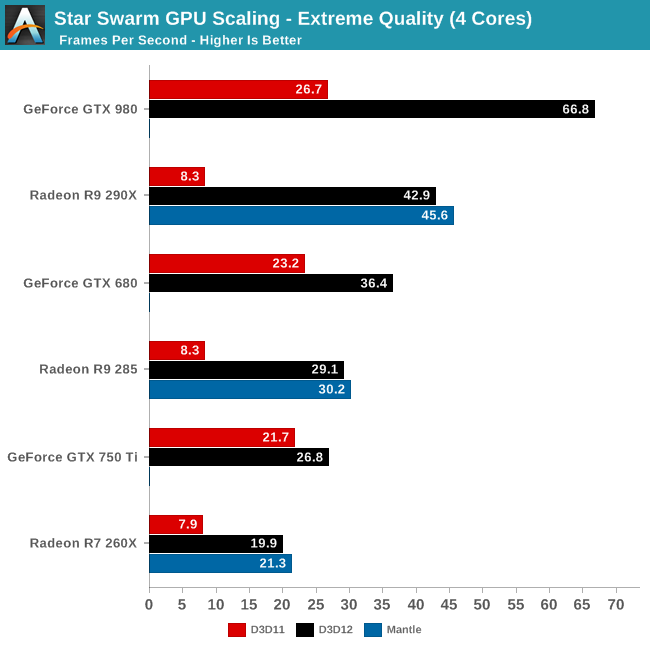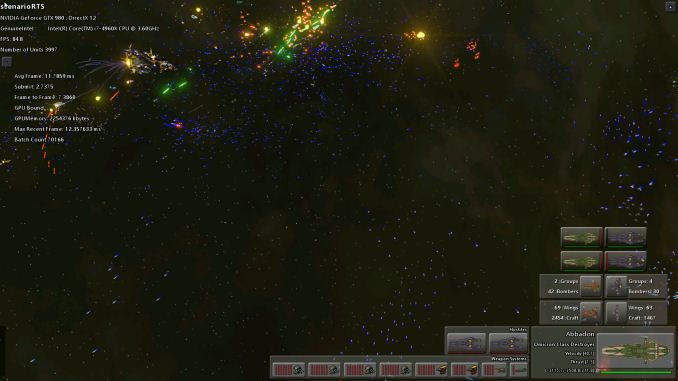The DirectX 12 Performance Preview: AMD, NVIDIA, & Star Swarm
by Ryan Smith on February 6, 2015 2:00 PM EST- Posted in
- GPUs
- AMD
- Microsoft
- NVIDIA
- DirectX 12
Star Swarm & The Test
For today’s DirectX 12 preview, Microsoft and Oxide Games have supplied us with a newer version of Oxide’s Star Swarm demo. Originally released in early 2014 as a demonstration of Oxide’s Nitrous engine and the capabilities of Mantle, Star Swarm is a massive space combat demo that is designed to push the limits of high-level APIs and demonstrate the performance advantages of low-level APIs. Due to its use of thousands of units and other effects that generate a high number of draw calls, Star Swarm can push over 100K draw calls, a massive workload that causes high-level APIs to simply crumple.
Because Star Swarm generates so many draw calls, it is essentially a best-case scenario test for low-level APIs, exploiting the fact that high-level APIs can’t effectively spread out the draw call workload over several CPU threads. As a result the performance gains from DirectX 12 in Star Swarm are going to be much greater than most (if not all) video games, but none the less it’s an effective tool to demonstrate the performance capabilities of DirectX 12 and to showcase how it is capable of better distributing work over multiple CPU threads.
It should be noted that while Star Swarm itself is a synthetic benchmark, the underlying Nitrous engine is relevant and is being used in multiple upcoming games. Stardock is using the Nitrous engine for their forthcoming Star Control game, and Oxide is using the engine for their own game, set to be announced at GDC 2015. So although Star Swarm is still a best case scenario, many of its lessons will be applicable to these future games.
As for the benchmark itself, we should also note that Star Swarm is a non-deterministic simulation. The benchmark is based on having two AI fleets fight each other, and as a result the outcome can differ from run to run. The good news is that although it’s not a deterministic benchmark, the benchmark’s RTS mode is reliable enough to keep the run-to-run variation low enough to produce reasonably consistent results. Among individual runs we’ll still see some fluctuations, while the benchmark will reliably demonstrate larger performance trends.
The Test
For today’s preview Microsoft, NVIDIA, and AMD have provided us with the necessary WDDM 2.0 drivers to enable DirectX 12 under Windows 10. The NVIDIA driver is 349.56 and the AMD driver is 15.200. At this time we do not know when these early WDDM 2.0 drivers will be released to the public, though we would be surprised not to see them released by the time of GDC in early March.
In terms of bugs and other known issues, Microsoft has informed us that there are some known memory and performance regressions in the current WDDM 2.0 path that have since been fixed in interim builds of Windows. In particular the WDDM 2.0 path may see slightly lower performance than the WDDM 1.3 path for older drivers, and there is an issue with memory exhaustion. For this reason Microsoft has suggested that a 3GB card is required to use the Star Swarm DirectX 12 binary, although in our tests we have been able to run it on 2GB cards seemingly without issue. Meanwhile DirectX 11 deferred context support is currently broken in the combination of Star Swarm and NVIDIA's drivers, causing Star Swarm to immediately crash, so these results are with D3D 11 deferred contexts disabled.
For today’s article we are looking at a small range of cards from both AMD and NVIDIA to showcase both performance and compatibility. For NVIDIA we are looking at the GTX 980 (Maxwell 2), GTX 750 Ti (Maxwell 1), and GTX 680 (Kepler). For AMD we are looking at the R9 290X (GCN 1.1), R9 285 (GCN 1.2), and R9 260X (GCN 1.1). As we mentioned earlier support for Fermi and GCN 1.0 cards will be forthcoming in future drivers.
Meanwhile on the CPU front, to showcase the performance scaling of Direct3D we are running the bulk of our tests on our GPU testbed with 3 different settings to roughly emulate high-end Core i7 (6 cores), i5 (4 cores), and i3 (2 cores) processors. Unfortunately we cannot control for our 4960X’s L3 cache size, however that should not be a significant factor in these benchmarks.
| DirectX 12 Preview CPU Configurations (i7-4960X) | |||
| Configuration | Emulating | ||
| 6C/12T @ 4.2GHz | Overclocked Core i7 | ||
| 4C/4T @ 3.8GHz | Core i5-4670K | ||
| 2C/4T @ 3.8GHz | Core i3-4370 | ||
Though not included in this preview, AMD’s recent APUs should slot between the 2 and 4 core options thanks to the design of AMD’s CPU modules.
| CPU: | Intel Core i7-4960X @ 4.2GHz |
| Motherboard: | ASRock Fatal1ty X79 Professional |
| Power Supply: | Corsair AX1200i |
| Hard Disk: | Samsung SSD 840 EVO (750GB) |
| Memory: | G.Skill RipjawZ DDR3-1866 4 x 8GB (9-10-9-26) |
| Case: | NZXT Phantom 630 Windowed Edition |
| Monitor: | Asus PQ321 |
| Video Cards: | AMD Radeon R9 290X AMD Radeon R9 285 AMD Radeon R7 260X NVIDIA GeForce GTX 980 NVIDIA GeForce GTX 750 Ti NVIDIA GeForce GTX 680 |
| Video Drivers: | NVIDIA Release 349.56 Beta AMD Catalyst 15.200 Beta |
| OS: | Windows 10 Technical Preview 2 (Build 9926) |
Finally, while we’re going to take a systematic look at DirectX 12 from both a CPU standpoint and a GPU standpoint, we may as well answer the first question on everyone’s mind: does DirectX 12 work as advertised? The short answer: a resounding yes.












245 Comments
View All Comments
eanazag - Monday, February 9, 2015 - link
Yes, and they need more millions of machines to attract developers. Find any app that exists on iOS, Android, and Windows and you'll see that the Windows version is usually lagging in support or features. Example: Star Wars Commander receives the same updates iOS does weeks later.They absolutely need developers to get on board. When they do, there should be a corresponding stream of cash flow in the Windows store.
Blessedman - Tuesday, February 10, 2015 - link
This is 100% correct... Ask any Machead if they would prefer Max Excel or Windows Excel, it is a clear choice that the windows version of Excel is far away a better product. When they can develop for an audience, do you think they would rather show off their product on the niche market (anything other than windows)?Blessedman - Tuesday, February 10, 2015 - link
Errr This isn't 100% correct.SparkySamza - Tuesday, February 10, 2015 - link
yes but numbers on mac vs mac excel, numbers wins every time cause numbers is a boss.Christopher1 - Monday, February 16, 2015 - link
True, but Windows 8 has the Store and it is a PAID upgrade from Vista and 7 so..... that comparison sorts falls flat in the real world.ymcpa - Saturday, February 7, 2015 - link
It's free only for the first year and it's not free to OEMs and large enterprise customers, who use software assurance anyways. They want everyone to upgrade to create a large enough user base to attract developers again. This will benefit windows tablets and phones and might make them competitive against ios and android. The only thing really holding tablets and phones back is the app selection. On the other hand, Google's only reason for giving away free software and service s to establish a large user so that the can sell ads to target that user base. In that scenario, you are the product.bitcrazed - Saturday, February 7, 2015 - link
"It's free only for the first year .."No. Win 10 is a free upgrade if you upgrade within a year of initial release. There is no fee to be paid after the 1st year.
Because we now live in a world where one doesn't need to replace one's machine every 3 years in order to be able to run the next OS version, Microsoft has learned that it needs to incentivize users to upgrade to newer OS' in order to prevent what happened with XP:
Although Microsoft had released Vista, 7 and 8, until fairly recently, a considerable percentage of their userbase were still running XP. Microsoft had to extend the support lifespan of XP twice to avoid leaving XP users without an upgrade path, but still they refused to upgrade. Then Microsoft could do no more and even extended support expired resulting in a larger number of upgrades from XP.
My offering Win10 as a free upgrade, Microsoft (and the entire industry) hopes to encourage users to upgrade from their current OS - XP, Vista, 7 or 8.x to the new OS sooner rather than later.
hwangeruk - Saturday, February 7, 2015 - link
Eh? His "free for the first year" comment was correct, stop splitting hairs.Microsoft is not trying to prevent what happened with XP at all, that's just wrong.
MS need apps for mobile, so wants a mass of users to get the tablet and phone space back.
They also want to win some hearts and minds as Windows 8 had a mixed reception (even though after 8.1 updates it was fine, the damage was done. Like games with launch issues sometimes don't recover from negative early reviews)
This has 0 to do with XP, and the XP extended support for only for paying customers not generally consumers. This move has 0 to do with XP, you are so wrong on that.
zodiacfml - Sunday, February 8, 2015 - link
It is free. They put it for free for the first year of the OS so that people are forced to upgrade immediately and not any amount of time longer than that as it that defeats the purpose of putting a huge percentage of people into just one, current operating system.Besides, adopters would be will beta testers with little obligation from MS.
Wwhat - Sunday, February 8, 2015 - link
But what does windows10 desktop to do with getting the tablet and phone space? And what do you mean with "get the tablet and phone space back", back? MS never had that market ever, nor is MS likely to get it.But yes, they are likely hoping to gain from 'an appstore' and 'cloud' and the always listening and handy for advertisers and security services alike voice-command thing.
All of which exemplifies the reason to worry..